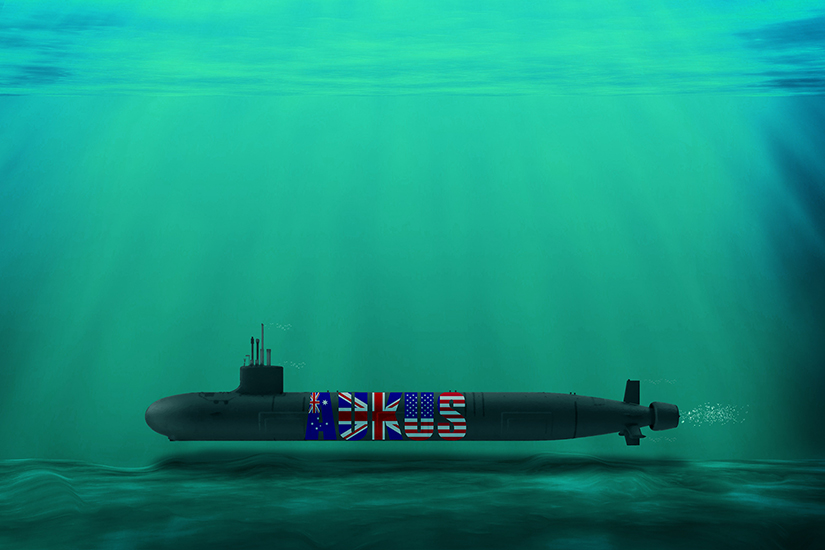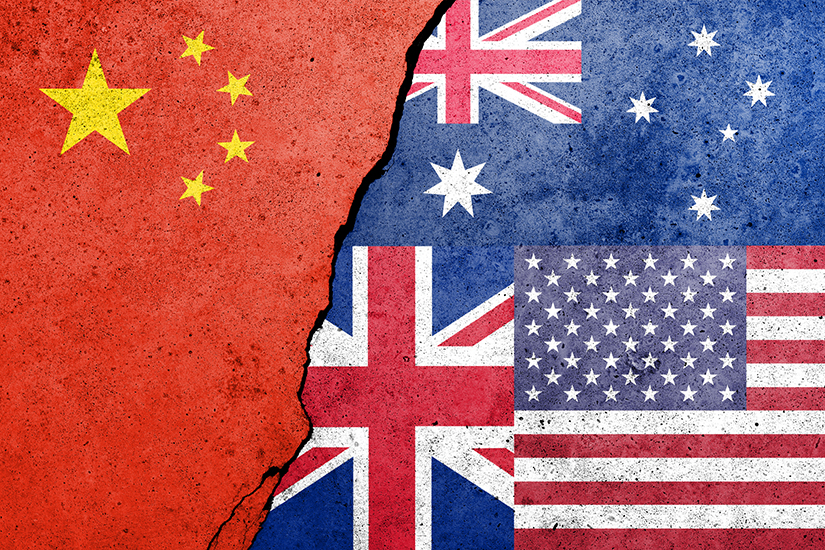Introduction
The announcement of the Australia-United Kingdom-United States “AUKUS” trilateral partnership in September of 2021 significantly impacted the strategic dynamics of the Indo-Pacific.[1] The joint commitment to defence collaboration around nuclear-powered submarines and other advanced technologies came as a “strategic shock” to the region, and as cooperation progresses, AUKUS continues to attract fierce debate, and criticism, in some quarters.
Now the AUKUS project is fully underway, with a well-defined institutional structure and “Optimal Pathway” toward submarine acquisition announced earlier this year, it’s worth re-examining some of the outstanding geopolitical questions and implications of this endeavour to reveal how it might shape the future strategic environment. The following appraisal extrapolates upon an earlier International Information Network Analysis by the author in 2021, to reflect subsequent developments.[2]

AUKUS: A “strategic minilateral”
To appreciate the significance and implications of AUKUS fully we need to categorise what it actually entails and represents as an institutional arrangement, beyond pure trilateral defence-technological cooperation, now we possess further details on the project. It has varyingly been classified as form of “security architecture”, a “defence pact” and even a “military alliance” - is it any or all of these things?[3]
It is officially referred to as a “Trilateral Security Partnership” – one dedicated to defence-technology collaboration, but with the Emphatic purpose of enhancing deterrence – for Australia nationally, and as a contribution to the US alliance front in the Indo-Pacific. I will recapitulate the formal institutional details here only briefly, as these are already well known to the strategic community.
The institutional super-structure of AUKUS revolves around two “Pillars” headed by a Senior Officials Group and Joint Steering Groups. “Pillar I” is the centrepiece endeavour to provide Australia with nuclear-powered submarine capability is supported by nine Working Groups and overseen by the Australian Submarine Agency (ASA), which was established in July 2023 to provide management and oversight of the submarine program (replacing the earlier Nuclear-Powered Submarine Task Force).[4] Plans for realising the SSN (Submersible Ship: Nuclear-Powered) project are outlined in the Optimal Pathway, announced at a trilateral summit in San Diego on 13 March 2023. This projects the provision of USS-Virginia Class submarines to Australia by the early 2030s, followed by the equipping of first, the Royal Navy, and then the Royal Australian Navy, with a new AUKUS-class SSN by the late 2030s, with joint training and Anglo-American submarine rotations to Australia occurring in the interim.[5]
Pillar II contains Eight additional Working Groups dedicated to collaboration on developing other critical defense and security capabilities, including: (i) underseas capabilities (through the AUKUS Undersea Robotics Autonomous Systems (AURAS) project), (ii) Quantum technologies (through the AUKUS Quantum Arrangement (AQuA), (iii) Artificial intelligence and autonomy, (iv) advanced cyber capabilities, (v) Hypersonic and counter-hypersonic capabilities, (vi) electronic warfare, (vii) innovation, and (viii) information sharing.[6]
But AUKUS is undoubtedly more than just a major defence deal. The “superstructure” of the agreement and the institutional organs just described above are just the specifics of the AUKUS agreement itself. Beyond this lies a far deeper and broader “substructure” upon which AUKUS is founded. If we factor-in all the political, ideological, strategic, defence, military, intelligence, economic and cultural ties that exist between the three member nations, considered holistically AUKUS takes on a rather different hue.
To elaborate – Australia and the US, and the UK and the US, are treaty allies (through ANZUS and NATO respectively) with an extremely close convergence of interests and values. The relationship between Australia and the UK is defined as a “Strategic Partnership.” Australia’s bilateral security relations with the US are framed through the 1951 ANZUS (Australia-New Zealand-United States) alliance treaty. As a consequence of New Zealand dropping out of ANZUS in 1986, due to a prohibition on hosting American nuclear-powered or armed vessels in its ports, the former trilateral is effectively a bilateral Australian-US arrangement at this time. Bilaterally, Australia and the US have sought to augment their defence relationship, through increased (rotational) deployments in northern, intensified joint training, and overall enhanced multi-domain cooperation (the Force Posture Initiative).[7] Conversely, Australia as a former British colony/Dominion has a long historical pedigree of defence cooperation with the UK, which contrary to common perceptions, extended well into the 1960s.[8] Though lesser Anglo-Australian ties have remained until the present, with London’s Indo-Pacific “Tilt” policy they have been re-energised, not least through AUKUS, but also the provision of Type 26/Hunter Frigates for the Royal Australian Navy.[9] Britian’s capability to deploy a Carrier Strike Group to the Indo-Pacific, demonstrated in 2021, indicates a desire for a visible presence in Australia’s region of primary strategic interest.
When these deep and re-vitalised alignments are viewed as a “composite” – unofficially - it would not be a stretch to claim that all three nations are “allies” in the non-treaty sense of the term. All three are members of the Five-Eyes intelligence sharing agreement (the first, second, and third most important partners, respectively), and all have close political, mil-mil and defence ties as well as being “Anglosphere” nations who have a long track record of co-deployment and operations.
A great deal of disparate “alliance infrastructure” between the partners is already in place – staff exchanges, personnel embedments, joint exercises and interoperability - especially in the naval domain. This insures a level of “trust” between them second to no other combination. Added up it starts to look like something of a de facto trilateral alliance relationship. As one senior US official put it, AUKUS is “a fundamental decision that binds decisively Australia to the United States and Great Britain for generations”.[10] While they were referring to the submarine program, this statement can apply to their joint strategic commitment too, as will be demonstrated below.
The best way to conceptualise AUKUS is as follows. It is clearly a form of security alignment, but officially falls short of a bona fide military alliance due to the absence of a trilateral mutual defence treaty.[11] Thus I would classify it as a “strategic minilateral” type of security cooperation. There are many forms of less-developed minilaterals, which focus on economic or single-issues in the region, but like the Quad and the Trilateral Strategic Dialogue (TSD), AUKUS is designed with strategic intent and for strategic effect on the regional balance of power. While it’s not technically accurate to identify it as a “military alliance” – and presenting it as such is recognised as provocative – there are strong indicators that it might well end up functioning as such. Indeed, a Brookings Institution Commentary dubbed it an “emerging alliance at sea” and pointed out some following alliance-like characteristics/functions (upon which I elaborate below).[12]
The wider implications of AUKUS:
AUKUS has generated a lot of debate excited a lot of controversy both domestically in Australia and around the Indo-Pacific region. I will highlight three select issues in ascending order of significance.
From the defence-technological perspective, one of the big implications of AUKUS is its potential to serve as a model and as a proving ground for better facilitating such inter-allied cooperation. Monique Taylor argues that ‘If successful, the trilateral integration of defense industrial and technological bases and supply chains would enable seamless collaboration and interoperability among AUKUS partners.’[13] If the US is serious about its intention to assist key allies and partners through collaborative project development or procurement, then the existing processes needs to be streamlined to facilitate this. There are ubiquitous calls in allied capitals for example to reform of the International Traffic in Arms Regulations (ITAR) to streamline and speed defence transfers. All are agreed –on both sides - of the need of faster and easier channels to expedite intra-allied projects. Moreover, the involvement of public-private partnerships and the resultant tension between commercial and strategic logics is an issue that will need to be overcome (on Pillar II). Tom Corben and William Greenwalt from the US Studies Centre have identified AUKUS as an opportunity that provides the means to reconceptualise how allies share defence technologies.[14] The modalities worked through in the AUKUS process will thus have wider applications for all potential allied def-tech collaboration with the US.
Perceptions of AUKUS in the region are important because the optics of how AUKUS is managed can have an impact upon perceptions of regional stability in the eyes of external actors. Predictably, Beijing has sought to denounce it as destabilising “typical Cold War mentality”.[15] Chinese influence operations, particularly in South East Asia, have been conducted to stir opposition there with limited success – Indonesia, Malaysia - by raising nuclear proliferation concerns. This wasn’t helped by the abrupt initial announcement and poor messaging from Canberra that followed the 2021 agreement. This appears to have died down given Canberra’s concerted efforts to ensure International Atomic Energy Agency (IAEA) compliance. Otherwise, Japan, the Philippines, and Taiwan have welcomed AUKUS for its contribution to maritime security and regional stability. Nevertheless, continued management of the strategic narrative and diplomatic messaging from Canberra around AUKUS is vital going forward.

AUKUS will undoubtedly lead to deeper integration of Australia - and perhaps the UK - into US regional defence strategy. AUKUS is about much more than just providing Australia with defence assets and capabilities. There has been criticism in Australia about how AUKUS potentially forfeits Australian sovereign decision-making in a regional crisis contingency where the US is involved. Former Prime Minister Paul Keating has been its strongest opponent. He has argued that “This arrangement would witness a further dramatic loss of Australian sovereignty, as material dependency on the United States robbed Australia of any freedom or choice in any engagement Australia may deem appropriate”.[16]
These claims are not entirely unfounded if we look closely. First, there is no doubt that AUKUS is an instrument in regional strategic competition with China, designed to deter and balance Chinese power. Abhijit Singh of the Observer Research Foundation argues ‘The plan to give Australia nuclear submarines also signals a clear intent on the part of AUKUS to balance China.’ This alone deepens Australian commitment to being part of the opposing US-led bloc against China.[17]
In this respect the devil is in the details. While the new capabilities of AUKUS will certainly improve Australian national deterrence towards an aggressor, they are essentially inseparable from US-led “integrated deterrence” – a concept that embedded and unites allies in a common front versus Beijing.[18] This could be a double-edged sword for Australia. Ashley Townshend of the Carnegie Endowment for International Peace indicates why:
‘the fact that U.S., UK, and, in time, Australian SSNs will be operating as a combined force—with Aussies also embedded on American and British subs—raises the spectre of horizontal escalation by forcing Beijing to consider the prospect that military action against any SSN, or the submarine base itself, could trigger the involvement of all three nations.’[19]
As Australia and the US continue their march towards the Force Posture Initiative – allocating or rotating more American personnel and assets to more Australian facilities - creating a “rear area base” or “coalition hub” - Australia becomes an extension of the US military deployment in the region, and thus inseparable from any Sino-US conflict scenario. This is by no means irrational or strategically undesirable but needs to be thoroughly thought out.
Prospects: What will AUKUS looks like in 10 years-plus time?
It’s difficult to give definitive answers to what the AUKUS enterprise will look like into the 2030s – a lot about AUKUS is speculative at this relatively early stage in the “life cycle”. Much will depend on a combination internal factors and external factors that could modify, accelerate, or derail the centrepiece projects.
If all goes according to plan in terms of the Optimal Pathway, by the 2030s Australia should have 3-5 Virginia-class boats in the water and up to 5 AUKUS-class SSNs building. Dependent upon the actions to respond militarily, or otherwise, by competitors, Australian national deterrence should be significantly enhanced, and with it, allied “integrated deterrence”.[20] Australia will have gained greater strategic weight in line with its relative size and with it potentially more diplomatic influence, especially on regional security matters.
However, while Australia plods towards its AUKUS objectives, it is unlikely that potential opponents will have stood idly by watching this happen. Indeed, it is likely they will have responded in kind with military advancements of their own, making AUKUS less impactful in future than its envisaged intent. For example - Beijing has just announced plans for the deployment of an additional 21 SSNs by the 2030s.[21] In the meantime, the Submarine Rotational Force West (the rotational deployment of UK/US SSNs to HMAS Stirling in Western Australia) could double the number of nuclear subs west of the international date line by 2031, with Australian Virginias adding to the complement by 2033, leading to 25 “allied” SSNs on permanent or rotational deployment by 2039, dispersed across Perth, Hawaii and Guam.[22] This goes some way towards filling the gap in capability until the AUKUS-SSNs appear.
Domestic political sustainability behind the AUKUS project also requires consideration – not just in Australia, but within its partner countries. In Australia we have seen very strong support for AUKUS continue under the Labor Government and would surely see the same if the Coalition returns to power in future. There has been some talk of political “horse-trading” within Labor ranks over “linkage” of support for AUKUS with other controversial causes.[23] One concern is the steep price tag (AUS $368bn), as the domestic cost of living and housing crises continue to bite in Australia. In such a context is it still feasible to retain such a high commitment to all aspects of AUKUS over the decades to come?[24]

Australia has no control over the governments in Washington or London. We cannot rule out changes in the American political climate brought about by a second Trump Presidency for example. What if Trump considers AUKUS a “bad deal” and seeks renegotiation of its terms? Likewise, there is the possibility that a further left-leaning Democratic Party may reconsider its resourcing priorities. In London – barring the assumption of power by a left-leaning Labour Government – we should see a strong continued commitment to AUKUS, not least due to the perceived economic benefits that the UK will derive from it. Yet, facing pressing threats from Russia in the European security sphere, Britian’s overall commitment of resources to the Indo-Pacific (The “Tilt”) may require pruning back in future.
Lastly, the potential expansion of AUKUS is a much-debated issue, particularly in relation to Japan – a US Treaty ally and “Special Strategic Partner” of Australia. Yet it is highly unlikely that Japan will become a full member of AUKUS with involvement in Pillar I – for a whole number of reasons this remains an exclusive trilateral agreement. There will be no “J-AUKUS”. Instead, Japan will likely seek to “plug-in” to aspects of Pillar II where collaboration could be extended – certainly as an “end-user”. Japanese policymakers have used the term “AUKUS-adjacent” or “AUKUS+J” to define their stance. Other countries mooted as potential members – Canada and New Zealand – are also a dim prospect at this stage.
In conclusion, AUKUS is a potential game-changer for Australia and the region. It is very ambitious and as is well-mapped out as could be reasonably expected, but there are enormous challenges in implementation that could endanger its sustainability. If successful, it will transform Australia’s defence posture and buttress the US alliance front in the Indo-Pacific, especially when placed alongside other major alliance and minilateral mechanisms for defence coordination.
(2023/09/14)
Notes
- 1 The White House,Joint Leaders Statement on AUKUS, 15 September 2021.
- 2 Thomas Wilkins, ‘The AUKUS Trilateral Security Partnership and what It Means for Australia’, International Information Network Analysis, Sasakawa Peace Foundation, Tokyo, 16 November 2021.
- 3 Tom Corben, Ashley Townshend & Susannah Patton, ‘What is the AUKUS partnership?’, 16 September 2021.: Thomas Wilkins, ‘Is AUKUS an really “alliance”?” for Melbourne Asia Review, 18 March 2022.
- 4 Australian Government: Australian Submarine Agency.
- 5 Prime Minister of Australia, Joint Statement, 14 March 2023.
- 6 British Government, FACT SHEET: Implementation of the Australia – United Kingdom – United States Partnership (AUKUS ),5 April 2022.
- 7 Australian Government, Department of Defence, United States Force Posture Initiatives.
- 8 Wayne Reynolds. ‘The wars that were planned: Australia's forward defence posture in Asia and the role of tactical nuclear weapons, 1945-1967.’ Australian Journal of International Affairs Vol, 53, No. 3 (1999), pp. 295-309.
- 9 British Government, ‘Indo-Pacific tilt: Foreign Secretary’s speech’, 29 September 2022.
- 10 Cited in Julian Lindley-French, ‘AUKUS: A British View’, Sage International.
- 11 Thomas Wilkins, ‘Alignment, not Alliance: The Shifting Paradigm of International Security Cooperation’ Review of International Studies, Vol. 38, No. 1, (January 2012), pp. 53-76
- 12 Bruce Jones et al. ‘Around the Halls: AUKUS Defines an Emerging Alliance At Sea’, Commentary, Brookings, 15 March 2023.
- 13 Monique Taylor, ‘Advanced Capabilities and Defense Integration in the Indo-Pacific’, Issue Brief, Institute for Security and Development Policy, Helsinki, 25 July 2023.
- 14 Tom Corben and William Greenwalt, ‘Breaking the barriers: Reforming US export controls to realise the potential of AUKUS’, Report, US Studies Centre, Sydney, 16 May 2023.
- 15 ‘China Says AUKUS On “Dangerous Path” With Nuclear Subs Deal’, Asahi Shimbun, 15 March 2023.
- 16 Andrew Probyn, ‘Australia's Embrace of Nuclear Submarine Technology Cements Role As Regional Foil Against China’, Analysis, ABC News, 16 September 2021.
- 17 Abhijit Singh, ‘AUKUS Has a Plan For China’, Raisina Debates, 17 March 2023.
- 18 Anna Pederson and Michael Akopian, ‘Sharper: Integrated Deterrence’, Center for New American Security.
- 19 Ashley Townshend, ‘The AUKUS Submarine Deal Highlights a Tectonic Shift in the U.S.-Australia Alliance’, Commentary, Carnegie Endowment for International Peace, 17 March 2023.[Italics added]
- 20 David Vergun, ‘Official Says Integrated Deterrence Key to National Defense Strategy’, US Department of Defense, 6 December 2022.
- 21 ‘China To Build 21 Nuclear Submarines By 2030’, Sky News Australia.
- 22 Townshend, ‘The AUKUS Submarine Deal.’
- 23 James Massola, ‘Victorian Labor Gives Albanese Deadline To Recognise Palestine’ The Sydney Morning Herald, 18 June 2023.
- 24 Peter K. Lee, Alice Nason, and Sophie Mayo, ‘The Social Licence for AUKUS Has Not Yet Been Earned’, The Interpreter, The Lowy Institute, 25 August 2023.

